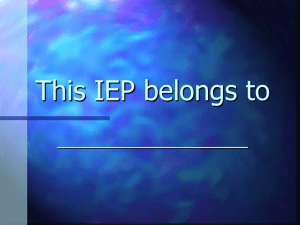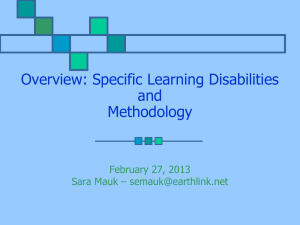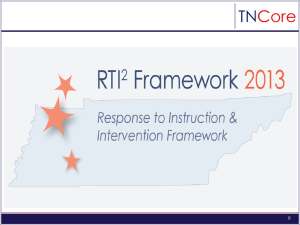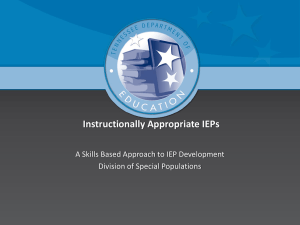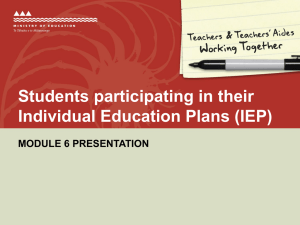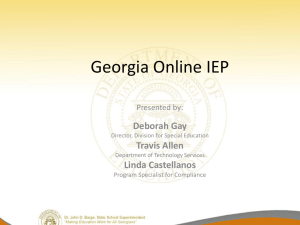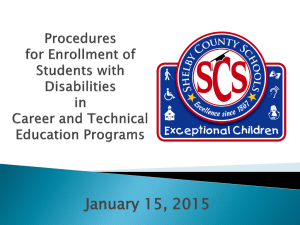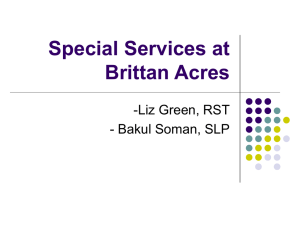Instructionally Appropriate IEPs
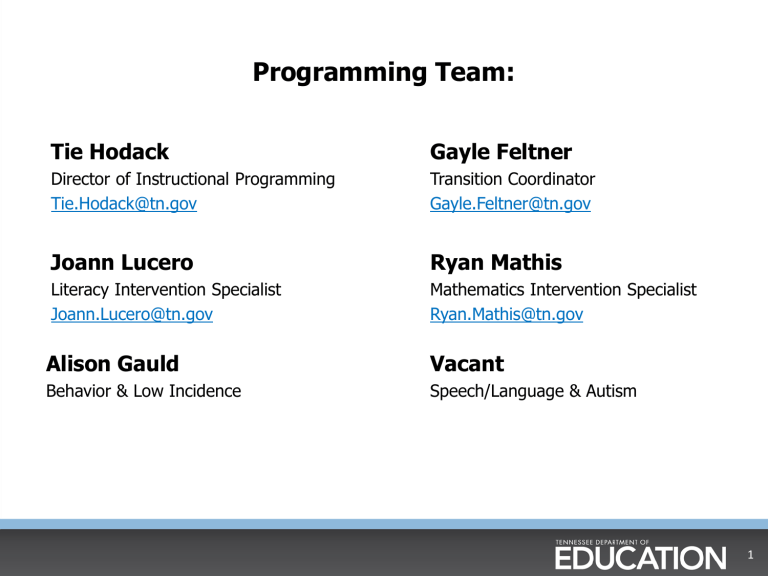
Programming Team:
Tie Hodack
Director of Instructional Programming
Tie.Hodack@tn.gov
Joann Lucero
Literacy Intervention Specialist
Joann.Lucero@tn.gov
Alison Gauld
Behavior & Low Incidence
Gayle Feltner
Transition Coordinator
Gayle.Feltner@tn.gov
Ryan Mathis
Mathematics Intervention Specialist
Ryan.Mathis@tn.gov
Vacant
Speech/Language & Autism
1
RTI² through Special Education Intervention
A Continuum of Intervention/Services
RTI² & Instructionally Appropriate IEPs
Division of Special Populations
Policy Change
Identifying students with a Specific Learning Disability
•
As of July 1, 2014, RTI² will be the framework used by teams to identify a student with a
Specific Learning Disability.
Evaluation timeline changes
•
As of January 29, 2014 TN is changing to a 60 calendar day evaluation timeline which aligns with federal guidelines. A program will be implemented within 30 calendar days from eligibility determination.
Short term objectives
• As of March 31, 2014, TN, will no longer have the requirement of benchmarks or short term objectives in IEPs, except for the students who take the alternate assessment.
Reteaching VS. Intervention
Reteaching
Tier I-Common Core Standards
Goal is to reteach standards that students are struggling with rather than specific skill deficits. These are your
“bubble kids”.
Standards Based Assessment:
Benchmark Assessment
Summative Assessment
Formative Assessment
Intervention
Tier II/III/Special Education
Intervention
Goal is provide research based interventions aligned to specific skill deficit(s) as identified by a universal screener.
Skills Based Assessment:
Skills based universal screener aligned to area(s) of deficit
Skills based Progress Monitoring specific to area(s) of deficit
Formative assessment
6
What does Tier III
Intervention tell us?
High quality research based intervention in specific area of deficit (more intensive than Tier II intervention)
Research shows 3-5% will need Tier III
45-60 minutes of explicit instruction daily, small groups
Universal Screener (K-8, recommended 9-12)(Based on national norms)
Survey/Specific-Level assessment (process to determine the basic skill area of deficit)
Then….what should special education intervention look like?
Setting the Stage
Continuum of Services
Special Education is the
Most Intensive Intervention
8
Common Across the Continuum of Service
RTI² through Special Education
District and School Teams
Skills Based Universal Screener
Assessments (ongoing and progress monitoring)
Recommended Instructional Time
Fidelity Monitoring
Parent Involvement
Professional Development
Writing Instructionally Appropriate IEPs
Present Levels of Instructional Performance (PLIP)
Annual Measurable Goals
Participation in State and District Assessment
10
Least Restrictive Environment: Indicator 5
• Children with IEP’s are served inside regular classroom 80% or more of the day.
– To the extent possible!!
• Should have evidence of LRE
-What does and does not work?
• Interventions are in addition to the 80% General Education Instruction
-Depends on area of deficit
• Full continuum of services
-Interventions are based on needs
• Best Practice
– Students are instructed in common core state standards by general education teacher. Not resource pull out to the extent possible.
11
IEP Overview
PLIP
Annual Measurable Goal
Assessment/Accommodation
Linked
12
IEP considerations
What must a student know and be able to do ?
• Common Core State Standards
• Areas of Concern
What accommodations and supports are needed to achieve the goal?
• Increase time in LRE
• Increase Student Independence
What specialized, individualized instruction is needed to achieve the goal?
• Interventions in Specific Areas
What will determine mastery?
• How will progress toward the goal be monitored?
• What data must be collected? How often?
13
Present Levels of Instructional Performance (PLIP)
Foundation of the IEP
• States what the student can do. That determines what the student can’t do (The special Education (LRP) 2013).
• Describes current academic and functional performance.
• Describes the unique needs of the student that the IEP will address.
• States how students current functioning impacts them on grade level standards (reference grade level standards in the PLIP).
– Identifies the student’s level of performance in those need areas
Without proper PLIPs, the IEP team cannot develop appropriate goals or select an appropriate program for the student.
14
5 Steps to PLIP
1.
Bring current data to the IEP meeting
2.
Be very specific and make sure it is an accurate reflection. Not how a child functions on a particular day but consistently (show a pattern).
3.
Review current test scores, progress monitoring & evaluation results prior to meeting
4.
Write in positive terms
5.
Use “stranger test” to assess PLIPs
Another district/teacher should be able to begin instruction immediately with the details in the IEP.
15
Measurable Annual Goal is Tied to Deficit Area(s)
Individual needs determination are the basis for a student’s goal
Directly linked to PLIP
Measurable
• Very specific
• Don’t be afraid to use numbers in goal
Goals relate to the student’s need for specially designed instruction to address the student's disability needs
16
IEP Task Force:
Nov 4
th
was first task force meeting
Will have a Manual & Implementation guide (Goal February)
17
Special Projects
18
Special Projects
Suzanne Keefe
•
Director of Special Projects
– 504
– Outreach/communication for all projects
– Professional development
– District request
– Parent/advocacy outreach
19



